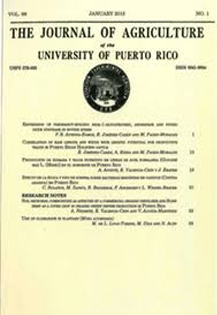Abstract
The association between the profile of mastitis-causing pathogens in milk samples from bulk tanks and milking practices was evaluated among herds with high (n = 15) and low (n = 14) milk quality. Milk quality grades were based on the somatic cell count (SCC) and the bacterial count (BC), according to milk quality data generated by the Dairy Industry Regulation Office of Puerto Rico during the months of August and September, 2016. The pathogen profile was determined using the PathoProof™ Mastitis Complete-16 Kit molecular test, while the milking practices used in each herd were determined through a questionnaire completed in person. The statistical analysis was performed with a PROC TTEST to determine differences in SCC and BC averages between the groups and contingency tables to calculate the association between milking practices and the profile of mastitis-causing pathogens, according to milk quality grade. Differences between dairy herds of low and high milk quality were reported (P < 0.001) for the averages of SCC (1,029,285 ± 76,879 vs. 212,667 ± 13,954 cells/mL) and BC (139,928 ± 47,474 vs. 4,440 ± 580.6 CFU/mL), respectively. Differences were detected between milking practices among dairy herds with high and low milk quality (P < 0.05). The most prevalent pathogens causing mastitis in dairy herds with low milk quality were Streptococcus agalactiae, Corynebacterium bovis, Staphylococcus aureus and Klebsiella spp., with 92.9%, 71.4%, 57.1%, and 35.7%, respectively. Meanwhile, Serratia marcescens was the most prevalent in herds with high milk quality reaching 40% (P < 0.05). Increasing milkers’ knowledge about the influence that each milking practice has on milk quality is imperative for dairy herds to produce high quality milk.

